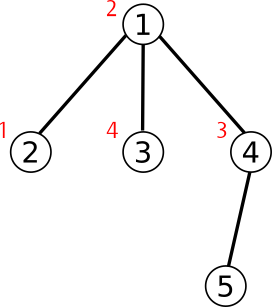2653.Duff in the Army
Time Limit: 1s Memory Limit: 256MBRecently Duff has been a soldier in the army. Malek is her commander.Their country, Andarz Gu has n cities (numbered from 1 to n) and n-1 bidirectional roads. Each road connects two different cities. There exist a unique path between any two cities.There are also m people living in Andarz Gu (numbered from 1 to m). Each person has and ID number. ID number of i-th person is i and he/she lives in city number ci. Note that there may be more than one person in a city, also there may be no people living in the city.  Malek loves to order. That's why he asks Duff to answer to q queries. In each query, he gives her numbers v,u and a.To answer a query:Assume there are x people living in the cities lying on the path from city v to city u. Assume these people's IDs are p1,p2,...,px in increasing order. If k=min(x,a), then Duff should tell Malek numbers k,p1,p2,...,pk in this order. In the other words, Malek wants to know a minimums on that path (or less, if there are less than a people).Duff is very busy at the moment, so she asked you to help her and answer the queries.
Malek loves to order. That's why he asks Duff to answer to q queries. In each query, he gives her numbers v,u and a.To answer a query:Assume there are x people living in the cities lying on the path from city v to city u. Assume these people's IDs are p1,p2,...,px in increasing order. If k=min(x,a), then Duff should tell Malek numbers k,p1,p2,...,pk in this order. In the other words, Malek wants to know a minimums on that path (or less, if there are less than a people).Duff is very busy at the moment, so she asked you to help her and answer the queries.
Input Format(From the terminal/stdin)
Input The first line of input contains three integers, n,m and q (1 \le n,m,q \le 105).The next n-1 lines contain the roads. Each line contains two integers v and u, endpoints of a road (1 \le v,u \le n, v \neq u).Next line contains m integers c1,c2,...,cm separated by spaces (1 \le ci \le n for each 1 \le i \le m).Next q lines contain the queries. Each of them contains three integers, v,u and a (1 \le v,u \le n and 1 \le a \le 10).
Output Format(To the terminal/stdout)
Output For each query, print numbers k,p1,p2,...,pk separated by spaces in one line.
Sample Input
5 4 5 1 3 1 2 1 4 4 5 2 1 4 3 4 5 6 1 5 2 5 5 10 2 3 3 5 3 1· · \n · \n · \n · \n · \n · · · \n · · \n · · \n · · \n · · \n · · \n
Sample Output
1 3 2 2 3 0 3 1 2 4 1 2· \n · · \n \n · · · \n · \n
Hints
Graph of Andarz Gu in the sample case is as follows (ID of people in each city are written next to them): 